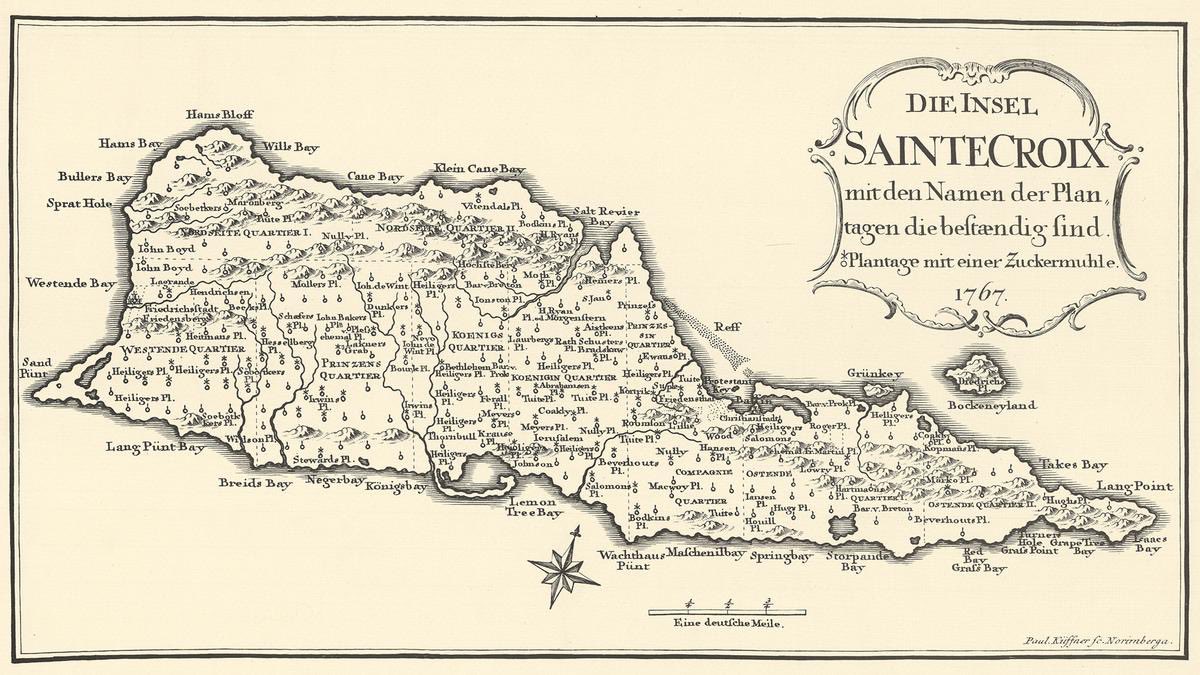#CLST6 For this #CYO3 on #Identity I listened to an Arch&Anth podcast interview with Dr. Justin Dunnavant. Dr. Dunnavant is a postdoctoral fellow at Vanderbilt University who specializes in African diaspora archaeology.
In particular, Dr. Dunnavant is interested in learning more about the lives of the 12 million recorded slaves stolen from Africa and sold into the Transatlantic Slave Trade within the last 500 years. Dunnavant estimates the unofficial numbers are actually upwards of 20 million.
Dr. Dunnavant& #39;s research is on the Caribbean Island of St. Croix in the U.S. Virgin Islands. Before Christopher Columbus renamed the island Santa Cruz (Holy Cross), St. Croix was known by the indigenous Taino as Ay Ay.
The continued use of the island& #39;s European name today, Dunnavant pointed out, is a good example of how colonialism lives on.
Dunnavant drew special attention to the way that the Western European terms "pre-colonialism" & "post-colonialism" are dysfunctional.
Dunnavant drew special attention to the way that the Western European terms "pre-colonialism" & "post-colonialism" are dysfunctional.
In class we discussed how the separation of Greek art into 3 categories - the Archaic, Classical, & Hellenistic - draws unfair & inaccurate lines in the sand as to when certain styles end and others begin.
Dunnavant argued the same thing in terms of the designation between pre & post colonialism. It& #39;s an oversimplification of a much more complex history. Likewise, it doesn& #39;t play well with the field of archaeology which operates on a continuum
Many entities temporarily controlled St. Croix after the first Europeans invaded in 1493 including France, England, & the Knights of Malta. It wasn& #39;t until the early 18th century that Denmark finally took full control & The Danish West India Company was born.
Dr. Dunnavant& #39;s latest set of terrestrial excavations in St. Croix have been at a plantation called Estate Little Princess where sugarcane used to be the main commodity.
The slave quarters at Estate Little Princess are organized into community blocks. The quarters themselves are so small that people likely only used them for sleeping. Otherwise, Dummavant & his team believe that enslaved people lived the majority of their lives outside the home.
Hundreds of shirds, British ceramics, tobacco pipes, & Afro-Caribbean wares made on nearby islands attest to the type material culture of those enslaved by the Danish.
Notably, the Danes maintained a free port legislation.
Notably, the Danes maintained a free port legislation.
This means that unlike the French or British controlled Caribbean, the Danish controlled Caribbean was multicultural resulting in a wider range of diverse artifacts from all over the world.
One of Dr. Dunnavant& #39;s most intriguing research questions investigates the interplay between slavery and ecology.
Terraforming is the term Dunnavant uses to describe the
deliberate mutilation of the environment for the purposes of plantation construction.
Terraforming is the term Dunnavant uses to describe the
deliberate mutilation of the environment for the purposes of plantation construction.
Terraforming has been tied to increased shoreline erosion & increased sheet erosion.
In addition to the construction of plantations, colonial St. Croix began the tradition of constructing its buildings out of coral rather than stone.
In addition to the construction of plantations, colonial St. Croix began the tradition of constructing its buildings out of coral rather than stone.
Dr. Dummavant doubles as a maritime archaeologist to investigate the ways that colonial coral mining in and around St. Croix has affected oceanic environments. Thus far, he& #39;s identified brain coral as the most commonly harvested species for this purpose.
Whereas stratigraphy studies what lies under land, Dr. Dummavant uses bathymetry to study the ocean& #39;s depths and look for any physical clues that might indicate a coral mining location.
In 1989, a hurricane did major damage to St. Croix & its people, wiping out tons of potential excavation sites.
Tourism also poses a major threat. As the keystone of the island& #39;s economy, more & more resorts are being built everyday that destroy historical sites in the process.
Tourism also poses a major threat. As the keystone of the island& #39;s economy, more & more resorts are being built everyday that destroy historical sites in the process.
It felt slightly ironic to me that in African diaspora archaeology natural disasters are seen as a threat whereas in Classical archaeology (though it& #39;s rather morbid to say) natural disasters are often our strongest link to the past.
His point about tourism intrigued me however. Greece and Italy both rely on tourism pretty heavily to support their national economies. @FlintCLST6 has that ever interrupted you or your colleagues work?
I felt that I noticed more similarities than differences between African diaspora archaeology and Classical archaeology. Both seek to contextualize a commonly misperceived past while also aiming to recognize the lessons that contextualization might provide for the future.
Info. Citations:
"In the Caribbean, what is the relationship between ecology and the archaeology of slavery?" The Arch & Anth Podcast. Episode 110. April 2020. https://archandanth.com/episode-110-interview-with-justin-dunnavant/
"Saint">https://archandanth.com/episode-1... Croix." Encyclopædia Britannica. Feb. 2018. https://www.britannica.com/place/Saint-Croix">https://www.britannica.com/place/Sai...
"In the Caribbean, what is the relationship between ecology and the archaeology of slavery?" The Arch & Anth Podcast. Episode 110. April 2020. https://archandanth.com/episode-110-interview-with-justin-dunnavant/
"Saint">https://archandanth.com/episode-1... Croix." Encyclopædia Britannica. Feb. 2018. https://www.britannica.com/place/Saint-Croix">https://www.britannica.com/place/Sai...
"The Danish Colony in the West Indies." https://en.natmus.dk/historical-knowledge/historical-themes/danish-colonies/the-danish-west-indies/
Image">https://en.natmus.dk/historica... Citations:
"In the Caribbean, what is the relationship between ecology and the archaeology of slavery?" The Arch & Anth Podcast. Episode 110. April 2020. https://archandanth.com/episode-110-interview-with-justin-dunnavant/">https://archandanth.com/episode-1...
Image">https://en.natmus.dk/historica... Citations:
"In the Caribbean, what is the relationship between ecology and the archaeology of slavery?" The Arch & Anth Podcast. Episode 110. April 2020. https://archandanth.com/episode-110-interview-with-justin-dunnavant/">https://archandanth.com/episode-1...
https://images.app.goo.gl/c48TRqS5pPkYACHE6
https://images.app.goo.gl/c48TRqS5p... href=" https://images.app.goo.gl/Tx9Ti6nyNFPWo5Hn9">https://images.app.goo.gl/Tx9Ti6nyN...
https://images.app.goo.gl/zMdoxVV7K4cNrNdR9">https://images.app.goo.gl/zMdoxVV7K...
https://images.app.goo.gl/mFzKfAcwDvnVfj8M6">https://images.app.goo.gl/mFzKfAcwD...
https://images.app.goo.gl/gmfb1NBdNAmKNxyL7">https://images.app.goo.gl/gmfb1NBdN...
https://images.app.goo.gl/a16MsYdJtqrWD4mW8
https://images.app.goo.gl/a16MsYdJt... href=" https://images.app.goo.gl/xwQWJeThunfk4Zuk8">https://images.app.goo.gl/xwQWJeThu...
https://images.app.goo.gl/kAsJvXy44oL7WniF9">https://images.app.goo.gl/kAsJvXy44...
https://images.app.goo.gl/zMdoxVV7K4cNrNdR9">https://images.app.goo.gl/zMdoxVV7K...
https://images.app.goo.gl/mFzKfAcwDvnVfj8M6">https://images.app.goo.gl/mFzKfAcwD...
https://images.app.goo.gl/gmfb1NBdNAmKNxyL7">https://images.app.goo.gl/gmfb1NBdN...
https://images.app.goo.gl/a16MsYdJtqrWD4mW8
https://images.app.goo.gl/kAsJvXy44oL7WniF9">https://images.app.goo.gl/kAsJvXy44...

 Read on Twitter
Read on Twitter














